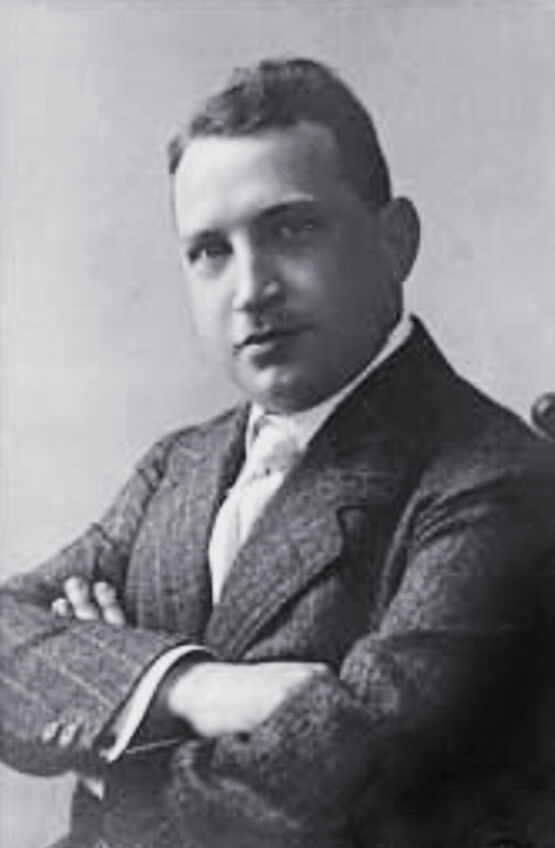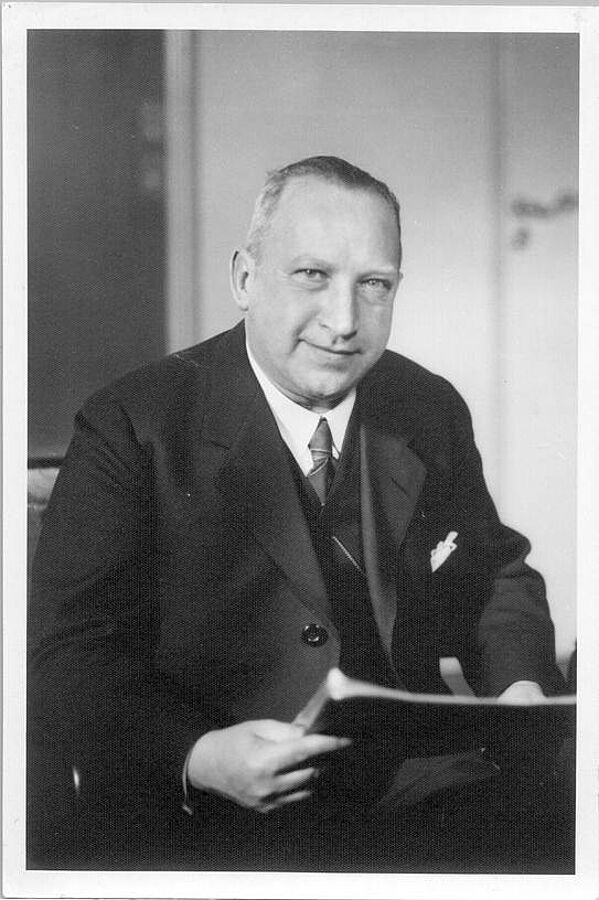
In our research on woodwind quintet music of the 1920s, we have only three works finished in 1924, but what a wonderful collection of three works! The most famous of the three was by Arnold Schoenberg, which has its own article. But, as revolutionary as Schoenberg’s work was, Theodor Blumer’s Quintet is as traditional as almost any of the 50 pieces we are examining in this series, looking backwards in its inspiration to the nineteenth century.
Theodor Blumer (born March 24, 1881; died September 21, 1964) was a composer, pianist and conductor who wrote five woodwind quintets (two in the 1920s) and two sextets (one in the 1920s) for quintet and piano. Biographies of his life are scarce and thin, and they require piecing together bits information from English and German sources (requiring Google translate, which in this case is a bit iffy).
Blumer’s Quintett für Blasinstrumente Op. 52 was published in 1924. His Tanz-Suite (Dance Suite), Op. 53 was published in 1925. Also his Sextet for piano and winds was written in 1922.
Theodor Blumer’s Life
Theodor was born on March 24, 1881 in Dresden (in the eastern part of Germany, near Czechoslovakia at the time) to Marie Blumer (née Eyßert, 1856-1941) and the violinist Theodor Blumer (1853-1932), who shared the same name. His father left Prague to perform at the Royal Chapel of Dresden in 1879.
Young Theodor was very talented musically and studied piano with Walther Bachmann and composition with Felix Draeseke at the Dresden Conservatory, where he graduated in 1902. He quickly established himself in Dresden as a pianist and accompanist. In 1906 he began working as a répétiteur and Kapellmeister at the Hoftheater in Altenburg. He was also active as a freelance pianist and composer starting in these years.
Blumer appears to have been drafted during World War I and served from 1917 to 1918 in the German campaign against Russia. We don’t know what he did in the war or whether he saw any combat.
Also in his home town was the Staatskapelle Dresden, one of the world’s oldest orchestras, founded in 1548. In 1919 he met the solo flutist of the orchestra, John Amans, who encouraged him to write music for wind instruments. This began a long-term collaboration with the woodwind players of the Staatskapelle, which resulted in a number of notable works we’ll discuss below. (John Amans later became solo flutist with the New York Philharmonic.)
Radio Pioneering
In 1924, embracing new technology, Germany began setting up a national network of radio stations. Blumer was a pioneer in conducting orchestras and programming music for the radio and worked from 1925 to 1931 as music director of the Dresden radio station. Between 1924 and 1931 he also founded the Dresden Soloist Association (Dresdner Solistenvereinigung) which included soloists and instrumentalists of the Staatsoper as well as the Fritsche String Quartet.
In 1931, he moved to work for the larger Reich Broadcasting (or Reichssender) in Leipzig (the Mirag Mitteldeutsche Rundfunk AG), where he headed the Middle German Radio Orchestra for 10 years.
Before and During World War II
In 1937, after the rise of the Nazi party to national leadership, Blumer joined the Nationalsozialistische Deutsche Arbeiterpartei (NSDAP, or National Socialist German Workers’ Party, otherwise known as the Nazi Party) with membership number 2,382,466. (Ahem. In spite of the lack of biographical material about Blumer and many other composers, the Germans were certainly quite precise in some types of record-keeping.) But, in spite of being a party member, World War II was a disaster for Blumer.
All of the available online Blumer biographies reduce the war years to one or two sentences if they mention it at all, and they don’t agree on much. One source says he was dismissed from the Leipzig radio station in 1940 “due to disagreements.” Another source says that live concert broadcasts were canceled because of the war sometime around 1941. (Both of these statements could be true.) Another source says he left the radio station in 1942 (or perhaps he left Leipzig then). In any case, it was the end of his radio career (and the circumstances may have voided his pension, too).
Ill-health forced him to stop performing in 1942. It’s unclear whether he stayed in Leipzig or returned to Dresden, but neither city was safe and in 1944, around 30 of his manuscripts burned after an Allied bombing raid (which presumably destroyed the rest of his home, too). This loss seems to have inspired him to compose a series of new works, but he was blacklisted from any performances until 1948 due to his NSDAP affiliation. He was also unsuccessful in trying to resurrect his performing career. Likewise, his wife, Hildegard Blumer-Ostkamp, an opera and concert singer, was unable to find work.
The Blumers moved to Charlottenburg in West Berlin in 1952 to try to improve their economic status. (It is likely that this was where he composed the Schweizer Quintet, in 1953.) The only evidence we have that they were, at least, somewhat successful was that they stayed until Theodor Blumer’s death in 1964. As he requested, he was buried in the Old Catholic Cemetery in Dresden, near the tomb of Carl Maria von Weber.
After his death, Frau Blumer-Ostkamp, his widow, made arrangements to send his music and memorabilia to the Sächsische Landesbibliothek – Staats- und Universitätsbibliothek Dresden (Sachsen State and University Library, known as SLUB) in Dresden, a long-term project that was completed after her death in 2001. This is the main research library collection for the composer. Other letters and autographs from Theodor Blumer are in the holdings of the Leipzig music publishers C. F. Peters and Benjamin/Sikorski in the Saxon State Archives Leipzig. An enterprising musicologist might do well uncovering more of the history and correspondence of Theodor Blumer and his music.

Blumer’s Quintet and Sextet Music
Quintett für Blasinstrumente, Op. 52
I. Sehr frisch und feurig
II. Romanze: Sehr ruhig und innig
III. Leicht fliessend—Ausserst lebhaft
IV. Finale: Sehr schwungvoll
According to the German-language Wikipedia: The publisher Wilhelm Zimmermann heard a performance of Blumer in a concert featuring his Sextet, Op. 45, and later showed up at Blumer’s Dresden apartment. He quickly acquired the Quintett für Blasinstrumente Op. 52 for his own publishing house. The two continued to correspond and were friends for the rest of Blumer’s life. Originally published in 1924, Zimmermann re-released the work in 2011, continuing their founder’s commitment to the work.
The parts (but not the score) from the original publication are available for download by the International Music Score Library Project in those countries where the copyright has expired.
This quintet is in four movements. It is hard to decide if the work is best described as Romantic or Late Romantic, or Post Romantic. To these ears it sounds a bit of a cross between Brahms and Richard Strauss, edging a bit more to Strauss. (Like Strauss, Blumer favors heroic horn declamations in this work.) The work lasts for about 21 to 22 minutes in most interpretations.
This is the only one of Blumer’s works that this author has performed, albeit roughly 25 years ago. It was a lot of fun to prepare and perform and was well-received by our audience. It ranks favorably with the other 1920s quintets in our series and I whole-heartedly recommend that other woodwind quintets take a good look at the piece.
Tanz-Suite (Dance Suite), Op. 53
Rigaudon (Allegretto, Leicht un zierlich)
Sarabande (Adagio, ma non troppo)
Menuet (Grazioso, leicht fließend)
Ungarischer Tanz [Hungarian Dance]
Valse Boston (Valse lente)
One step (Allegro molto, con brio)
Another work by Blumer from the 1920s is his Tanz-Suite (Dance Suite), Op. 53. It was published in Berlin by Simrock in 1925. The cover page also notes that it was available in London from Alfred Langnick & Co. and in Paris from Max Eschig & Co.
Later, another publisher, Richard Schauer, emigrated from Germany to England in 1939, so his publication of the Tanz-Suite was probably somewhere between 1939 and his death in 1952 in the U.K. It appears that Theodore Presser was his American agent, but it is probably out-of-print now. Still another edition was in Hamburg by Anton J. Benjamin in 1966.
More works
Another work dating from 1922 is Blumer’s Sextet in F Major (“Originalthema mit Veranderungen” or “Original theme and Variations”), Op. 45 for woodwind quintet and piano. It was published by Simrock in 1922, and later by Richard Schauer Music (and his U.S. agent, Theodore Presser). More recent editions include Rosewood Publications in Berkshire, England; and by Edition Silvertrust.
Blumer wrote this work to perform, himself, with the Dresden Bläservereinigung der Dresdener Staatsoper (Woodwind Quintet of the Dresden Opera) to whom he dedicates the work: A. Amant, J. König, A. Richter, A. Lindner, and W. Knochenhauer. The original Simrock edition has been digitized and the score and parts are available from the International Music Score Library Project for download in those countries where the copyright has expired (which means, in this case, America and Canada but not Europe).
In the Sextet, Op. 45, the winds present the theme without piano (Thema – Gesangvoll, ruhig), and the first variation (Fliessend und weich) is for piano solo, so it is not until the second variation (Sehr lebhaft und frisch) that the entire ensemble comes together. The third variation is a Pastorale; the fourth a Slavischer Tanz; the fifth a Romanze (which features 32nd note arpeggios in the piano for much of the variation). The Sixth Variation is a Humoreske in 5/4 time, with the Seventh Variation being the Finale.
Another Sextett (which also goes by the title Kammersymphonie), Op. 92 is also for piano and winds and is a hefty 31 minutes long. It appears the first publication was in Berlin by Reis & Erler in 1998.
An earlier work for woodwind quintet by Blumer is his Serenade und Thema mit Variationen, Op. 34, published by Simrock (and also available from Max Eschig in Paris) in 1918. (It seems unlikely that a Parisian publisher would have distributed a work by a current German composer during the war, despite any publishing agreements with Simrock, so it probably had to wait until after the Armistice, at least, before distributing the music. Eschig, in any case, probably would have been unaware that Blumer was serving in the German army in 1918.) A later edition is by Anton J. Benjamin in Hamburg in 1966.
Kinderspielzeug (Childrens’ Toys), Op. 64 has the movements: Ball; Teddybar (Teddy Bear); Puppe (Puppet), Aufmarsch der Puppen (Parade of Puppets); Alte Spielurh (Old Music Box); Schlitten Ball (Sleds). It was published in Leipzig by Zimmermann.
Schweizer Quintett, Suite (Swiss Quintet Suite) was published in Hamburg by Musikverlag Hans Sikorski, in 1953. The movements are: Prelude; Gavotte; Arietta; Introduktion; Thema and 7 Variations. The final movement is a set of variations on the Swiss folksong “Rosen im Tale” (translated as “Roses are Blooming in the Valley.” The duration is about 22 minutes.
There are two other manuscripts, probably unpublished, for woodwinds and voices.
Among the composition autographs included in the research library SLUB, (the Sächsische Landesbibliothek – Staats- und Universitätsbibliothek Dresden) is a setting of Carl Hauptmann text for a sacred piece of music “Quempastores Laudavere” for boys’ or women’s choir and wind quintet composed between 1925 and 1931. It appears to never have been published.
The SLUB library also mentions a manuscript of an Op. 79 – a work for alto and baritone by Blumer, with text by Walther Stein, scored for flute, oboe, clarinet, horn, string quartet and piano. Unfortunately, the Google translation of the title makes no coherent sense in English: “Werbung und Vollendung. – Schließ nun die samt´ne Wimper Nacht und laß mich lausche”
Recordings
The Moran Woodwind Quintet of the University of Nebraska-Lincoln School of Music recorded all of Blumer’s works for winds on Crystal Records in 1994: Crystal Records CD753, as part of a 2-CD release of all of Blumer’s works for winds.
When I first wrote about Blumer’s Op. 52 quintet in 2016, the only recording of the work I could find was by the Moran Quintet, which was only available on CD. Today there are several recordings on YouTube, including both live recordings in front of an audience and studio recordings.
I recently found a very nice live performance of Op. 52 by the Daraja Ensemble, recorded Nov. 2, 2015 with Grace Want, flute; Michael Homme, oboe; Michele von Haugg, clarinet; Sam Fraser, bassoon; and Joshua Blumenthal, horn (accompanied by a live cricket during the second movement, ya gotta love live music).
A very polished version of Op. 52 is by the Georgia Woodwind Quintet on an album entitled “Chroma,” is also available on YouTube, in four files: I. Sehr frisch und feurig; II. Romanze: Sehr ruhig und innig; III. Leicht fleizend – Auzerst lebheft; and IV. Finale: Sehr schwungvoll.
There is an excellent recording of the Sextett, Op. 45 of 1922, for woodwind quintet and piano by the Aura Ensemble of Kathrin Troester, flute; Barbara Bode, oboe; Udo Grimm, clarinet; Uwe Tessmann, horn; and Sergio Giordano, bassoon. They’ve recorded both the Op. 45 and 92 quintets on a CD recording on the Antes Edition label. The movements of Op. 45 are available on YouTube. As usual, YouTube makes it more difficult than it should be to search for all the movements, so I’ll list them: Thema; 1st Variation (piano solo); 2nd Variation; 3rd Variation; 4th Variation; 5th Variation; 6th Variation; and the Finale or 7th Variation.
As mentioned above, the Aura Quintet has also recorded Blumer’s other Sextet, Op. 92 and has also shared the 4 movements of this work on YouTube: I. Allegro non troppo; II. Scherzo (Presto); III. Andante Sostenuto [ ]; and IV. Rondo (Molto vivace).
The same work is also recorded by the Moran Quintet in Vol. II of its works by Theodor Blumer, but not available online.
This discography is hardly complete, and there are other assorted movements of Blumer’s works also on YouTube. But if other quintets want to perform, record and share their work online, there is plenty of room for new interpretations.
Credits
Photo of a younger Theodor Blumer is from the Sächsische Landesbibliothe – Staats- und Universitätsbibliothek Dresden (Sachsen State and University Library) (SLUB) in Dresden, where most of Blumer’s archives are now kept. The photo was taken by Martin Herzfeld in 1911 and is in the public domain.
The older portrait of Blumer, holding a score, is also from SLUB, but comes from the Ateliers Foto Schröter, in Leipzig, taken in 1940.
Wikipedia (English) has a basic biography of Theodor Blumer, but the German-language Wikipedia has a more extensive article.
The SLUBlog has a brief biography and photo on their site.
The SLUB library also has a webpage with its own biography with a list of some of its holdings (manuscripts and photos) from its collection.
“Claudia’s Flutepage” has a time-line biographical chart of Theodor Blumer (in English and German). It also lists many of his works with flute.
Copyright © 2024 by Andrew Brandt

